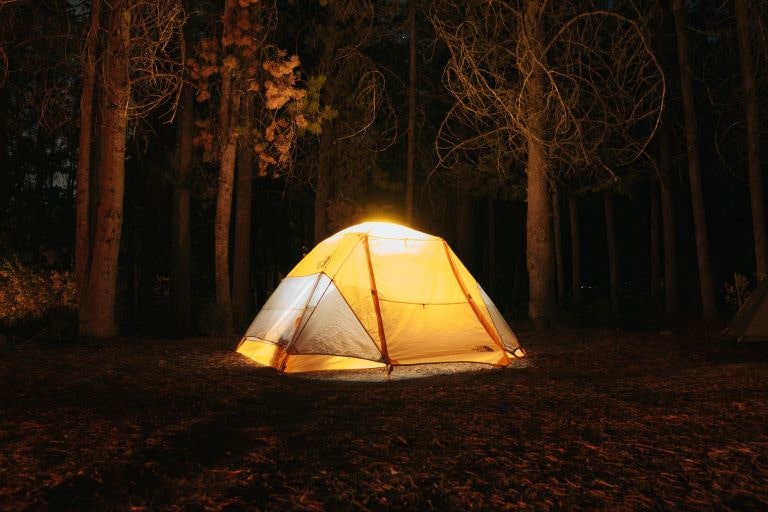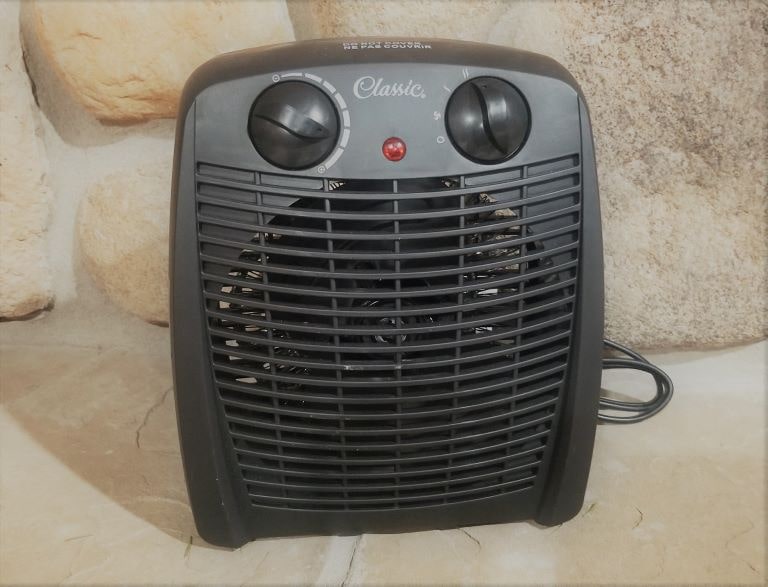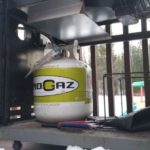
When planning a camping trip you’ll probably be dreaming of warm sunny days and clear temperate nights. As much as you might hope that will be the case, the weather can be unpredictable, even in the dead of summer. You can end up with chilly nights that will leave your nose frozen, especially up here in the northern hemisphere.
Being prepared for those cool nights will enable you to get a comfortable and warm sleep no matter the conditions. But how can you possibly heat a tent and keep it warm when you don’t have electricity? After all, tent fabrics are paper thin, offer little insulation and are usually set up directly on the cold hard ground.
Some of the answers for how to keep a tent warm without electricity might surprise you. In many cases you can use items you’re bringing along anyway or things that can be found around the campsite.
How to keep a tent warm without electricity
No matter how you plan to heat your tent in the first place, the key to keeping it warm will be a sustained heat source. Because most tents offer around zero insulating properties, as soon as you turn off that heat source, there is very little to keep the warmth inside the tent.
The exception to this rule is canvas tents. Canvas tents are made of high quality and durable materials which do provide some insulation. They block out winds effectively and can retain heat much more effectively than polyester or nylon tents.
Nylon and polyester tents provide little in the way of blocking out winds. The thin material doesn’t trap heat inside particularly well and the result is that the temperature inside the tent will usually resemble the temperature outside.
However, over the years people have tested many creative ways to keep warm in a tent. Some of them have had better success than others. And many methods are the same, or a spin on, ways that have been used for centuries.
If you want to keep warm in a tent, step one is finding the right location
If you build a house in an open field, the winds will swirl around you and you can expect your winter heating bills to soar. Just the same, if you set up your tent on top of a mountain with little protection from the wind, you’re going to feel those extreme weather conditions.
However, good planning of your tent location well will reduce those effects. Use trees to provide a barrier between your tent and the open winds. Finding a spot surrounded by trees is step one to keeping your tent warm. If there aren’t many around, use what’s available and hang a tarp on windy days to block as much wind as possible.
How to keep a tent warm without electricity…….safely
If you’ve found a nice spot to set up camp that’s out of the wind, that’s a great first choice. But it might not be as comfortable and warm in your tent as you’d like it yet.
That’s because the ambient air temperature will also play a major role in how warm it is inside.
If you want to heat and stay warm inside your tent without the use of electricity, it’s time to get creative. Here are some of our favorites:
1. Insulating Floor Mats
When trying to heat a tent it’s a good idea to first try to stop as much cold air as possible from entering the tent in the first place. This means insulating the tent where you can.
I would say that the floor is the easiest part of a tent to insulate. All it takes is a few insulated floor mats placed to cover as much of the floor space as you like. The more floor area covered, the more effective it will be at stopping the cold ground from infiltrating inside.
2. A Water Bottle Placed by the Fire
Using a hard plastic water bottle works well for this trick. And the bigger, the better! The larger it is, the more it can retain the heat for as long as possible. The method involved with this tent heating hack is to place the bottle near the campfire until it’s nice and warm. When you head off to bed, take the bottle with you and place it anywhere in the tent you like.
Placing it right inside your sleeping bag will work wonders. The water bottle will radiate heat for a good portion of the night.
One other thing to keep in mind for this method. If you leave a second water bottle near the fire when you head off to bed, you’ll have a refill if you happen to wake up in the middle of the night for a bathroom break. There’s nothing more painful than leaving a warm sleeping bag in the coldest part of the night. Keeping your tent warm and climbing back into a hot sleeping bag makes it all the more worth it.
3. Hot Rocks Retain Heat
Using hot rocks is a cool spin on the water bottle trick for keeping warm in a tent. Plus you can most likely find them around the campsite which makes this great for the backpack camper.
Essentially following the same rules as the water bottle trick, gather a few mid sized rocks around 6 inches in diameter. Place the rocks by the fire and let them warm. Be conscious of just how warm they are getting though. If they get too hot you won’t be able to use them safely. But if you get them to a nice temperature they will work really well at heating up a small tent.
Place the warm rocks inside the tent on a safe surface. If you have a plate or pot, that’s the ideal spot. You can also place them on a pad or blanket.

4. Propane Heaters Rated for Indoors
If you want to know how to stay warm in a tent with just one piece of equipment, this might be it. A propane heater can provide way more BTU’s than your tent would ever need. They’re lightweight and compact so they can be placed in a corner of the tent without being in the way and they most often use 1 pound propane cylinders.
To the surprise of many people, they are actually quite safe to use. Many models have been designed with tent campers specifically in mind. Tent heaters have safety mechanisms in place like automatic shutoff if it tips over, plus low oxygen sensors.
Regardless of all of the safety features, it’s still a good idea to have a carbon monoxide detector in the tent with you. Plus, make sure to read the specs for the heater so you know for sure that it is intended for tents and camping.
5. Solar Powered Heaters for off the Grid
Many people don’t like the idea of having a propane heater in such a small space. If it makes you a little uneasy too, then a better option might be a solar powered camping heater.
When we talk about solar powered heaters, they are most often powered by a solar panel that’s left outside. That way it can charge during the day and power the heater at night. They’re a great, reliable option for heating your tent, although it can become a lot of gear to bring along.

6. Sleeping Bags are Number One
When thinking about how to stay warm in a tent without electricity, remember that you’ll mostly be in there to sleep. That means you’ll be tucked away in a sleeping bag for most of the time. So, if you really want to know how to keep warm in a tent, the main answer is to buy a sleeping bag that is right for the climate.
Each sleeping bag will be rated up to a certain temperature. If you’re camping in upstate New York or Vermont, the evenings are going to get much cooler than in Florida or Georgia.
7. Sleeping Pads Provide Separation
A sleeping pad will provide you some separation from the cold ground. Many sleeping pads also have insulation and are rated to a certain temperature so you can easily choose the right one for your needs.
Additionally, sleeping pads can come in many different forms. Whether it’s an inflatable sleeping pad, a foam camping pad, air mattress or some other variation, they’ll all serve the same purpose in keeping you warm while you sleep.
8. Clothing for the Climate
The clothes you wear inside your tent, especially to sleep in, will have a big impact on your warmth. Choosing light, dry clothing is best for sleeping in. Make sure to change those socks before bed too. They’ll hold moisture from being worn all day which will turn cold in the night. It’s always much warmer and more comfortable to sleep in dry clothing.
If your head gets chilly, bring along a toque to sleep in. Not only do they keep your head warm; they also add a little cushion as a pillow.
9. Body Heat is a Good Thing
It’s easy to think that you need all kinds of special equipment to heat a tent without electricity, but don’t forget that your body heat alone will often be enough. Tents are small spaces and sleeping bags are designed to trap your body heat.
So before you go spending a bunch of money on specialty camping heaters, think about how much time you plan to spend in your tent in the first place. If it’s only for sleeping, chances are you’ll be good with body heat and a good sleeping bag alone.
Conclusion
Some of the best campsites to be found are off the beaten path which means there won’t be any electricity. Cold nights outside don’t have to equal cold sleepless nights in your tent. As long as you’ve come prepared or you know a few extra tricks like the rock heating hack, you’ll be able to keep your tent comfortably warm without any trouble.




